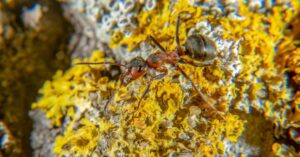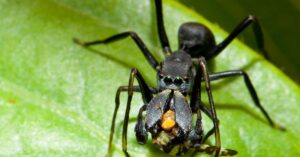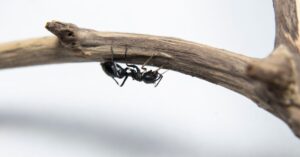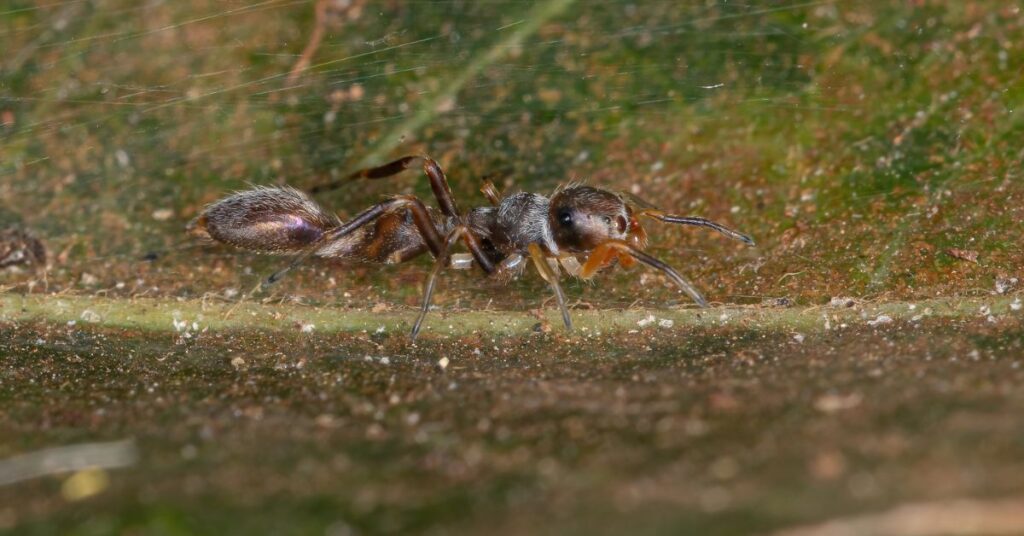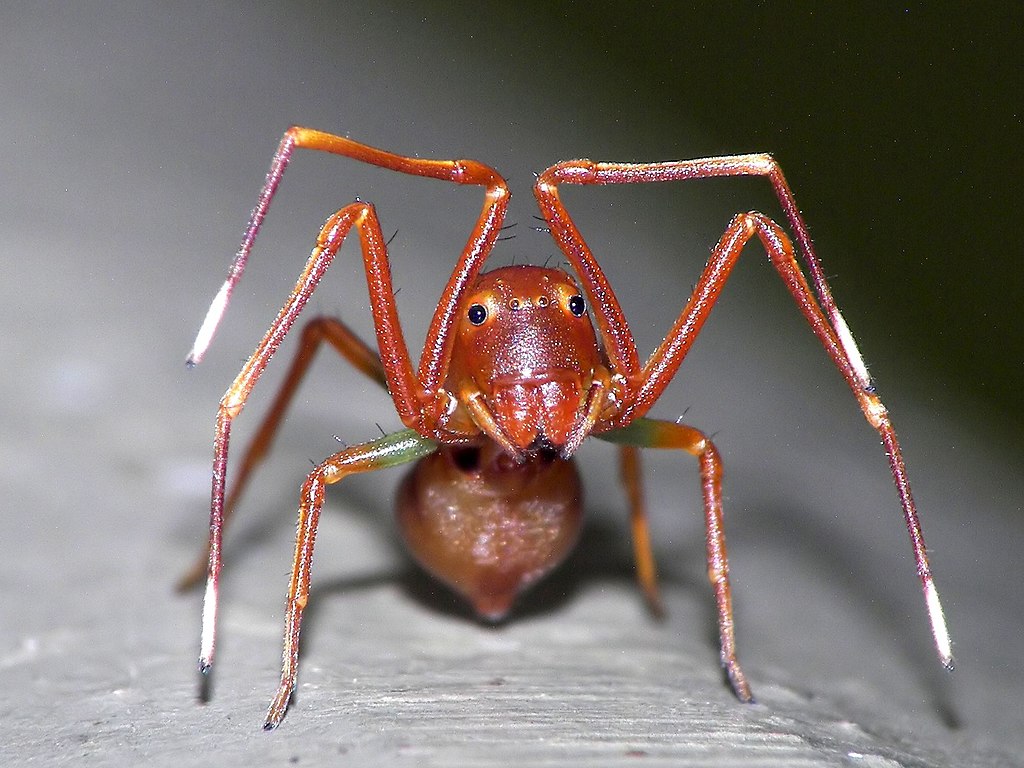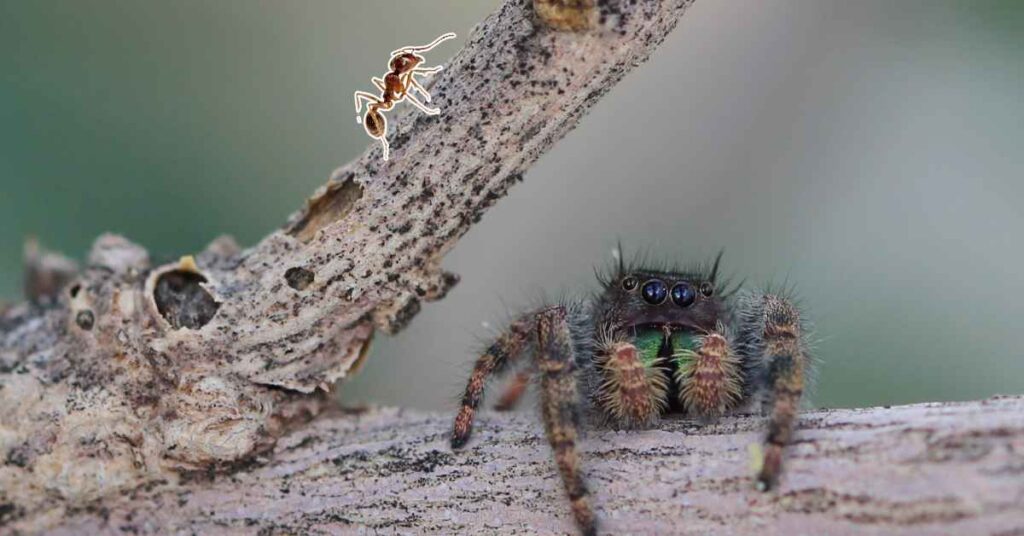
Spiders come in all shapes and sizes. We know they have eight legs and generally eight eyes, but is there a spider that looks like an ant? Is there such a thing as an ant mimic spider? After all, we all know what an ant looks like, but would we necessarily know if the ant we saw was actually a spider in disguise? And what would be the purpose of disguising yourself as an ant? Let’s answer the main question first.
So that’s the core of it. Let’s now dive in a bit deeper to find out more about this fascinating creature!
Why Impersonate an Ant?
It has been estimated that the world’s 25 million tons of spiders kill an astonishing 400–800 million tons of prey per year.
It’s no surprise then, that over millions of years, spiders have evolved into cunning and sophisticated hunters.
Any spider that either wants to hunt and eat ants, or wishes to avoid predators, using myrmecomorphy (impersonating ants) has become a very effective strategy.
DID YOU KNOW: Of the 49,000 plus identified spider species, over 300 have evolved bodies that resemble the three segments of an ant’s body.
These spiders also mimic ant behaviour – they walk around in a zig-zag pattern, waving their front legs around to mimic antennae and bob up and down as if searching for pheromone signals.
These strategies are also effective against predators who rely on visual clues, such as wasps or birds, and are not particularly interested in the taste of ants.
We shall now list some of the terms used to show the different ways in which ant mimicry can be applied.
Aggressive Mimicry
Aggressive mimicry is used by spiders to enable them to approach and prey on ants successfully.
Although they may not visually appear very ant-like (they are in fact adorable), many jumping spiders can mimic the movement and body-shape of an ant and so can get close enough to leap and attack without putting themselves in jeopardy.
Wasmannian Mimicry
Wasmannian mimicry occurs when two species live close to each other.
The spider will mimic varying features of the ants either with by using chemicals or even its appearance.
An example of this is the Slender Ant-Mimicking Jumping Spider, which attacks vulnerable young ants to adopt their odour and deter predators.
Batesian Mimicry
Batesian Mimicry is the term that describes a spider making use of its resemblance to ants to avoid being attacked by potential predators, sometimes including the ants themselves.
For example, as previously said, jumping spiders can mimic both the body shape and the movements of ants. Not only do jumping spiders attack certain prey this way, but it’s also a great defensive strategy.
Spiders That Look Like Ants
Genus Myrmarachne
M. formicaria.
Around 6mm in length, this tiny jumping spider resembles wood ants.
This species is confined to south-east of a line from the Wash to the Severn. It is widespread in western and central Europe but has not been recorded from Ireland or Denmark.
M. formicaria usually occurs on some type of grassland, sometimes very near the beach and on under-cliff.
There are many records from chalk grassland but also stony cliff ledges, saltmarsh, marram and fens. Jones-Walters (1997) reports it as relatively common in the New Forest mires where the common ant Myrmica scabrinodis is abundant.
It is an ant-mimic, usually found in company with ants, either running among grass or under stones. Both sexes are adult from May to July, with females until September.
Although local, this spider is fairly numerous at some sites and is possibly most frequent in damp places on under-cliff.
Japanese Ant-Mimic Spider (M. japonica)
The Japanese Ant-mimic spider is probably the most convincing one we’ve seen.
It has an elongated cephalothorax with relatively long chelicerae that projects forward in males. The cephalothorax has a waist, and the opisthosoma often has one too.
The colours can vary from black to yellow, depending on the ant species it is mimicking, and can change over the course of its life.
For example, one African species was observed to mimic a certain species of ants as a juvenile, and another ant species as an adult.
Their remarkable binocular vision is used to locate, stalk, and then ambush their prey.
With about 80 described and many undescribed southeast Asian species, Myrmarachne is the most diverse genus of jumping spider in this region and we are not going to list them all.
Genus Synemosyna
Another largely populated ant mimic spiders are the Synemosyna genus.
One example of this is the Slender Ant-mimic Jumping Spider (S.formica).
Although this jumping spider is preyed upon by ants, it will actually build its own home next to an ants nest.
However, the construction will be such that ants cannot penetrate it while the odour of the ant nest keeps other predators away. Quite nifty!
Genus Castianeira
Our third genus is the Castianeira genus.
Variegated Ant-Mimic Sac Spider (C. variata)
This shy and beautiful creature can be found in North and Central America.
Their body length is typically 7 to 9 mm, females being larger than males.
Although they don’t visually look like ants (they do look like spiders), they are great mimics. They bob their abdomens up and down, wave their front legs like antennae and move in a zig zag motion.
These spiders don’t actually prey on ants but do live near them, so their behaviour is purely to deter predators.
Common Patterned Ant-Mimic Ground Spider (Sergiolus montanus)
This is a brightly patterned spider, which is thought to be mimicking velvet ants, rather than true ants, as these deter many predators.
They don’t use webs to capture prey but are active hunters.
And finally on our list is the Amyciaea forticeps, or Ant-like Crab Spider as it’s more commonly known.
Yes, we know it’s a crab spider but bear with us on this.
When resting, it doesn’t look at all like an ant at all, but when hunting, it cleverly mimics the typical movements of a dying ant.
This attracts the attention of nearby worker ants and therefore increases its chances of grabbing an unsuspecting victim so we’ve included it in this list.
So to finish, we hope you now are aware that there are indeed spiders that look like ants and the reasons for behind it (its not just some weird kink). Evolution over millions of years has turned spiders into the hunting and survival machines that they are today. So be prepared that the next time you spot an ant, it might not be what you think it is at first glance! Until next time, stay spidery!


